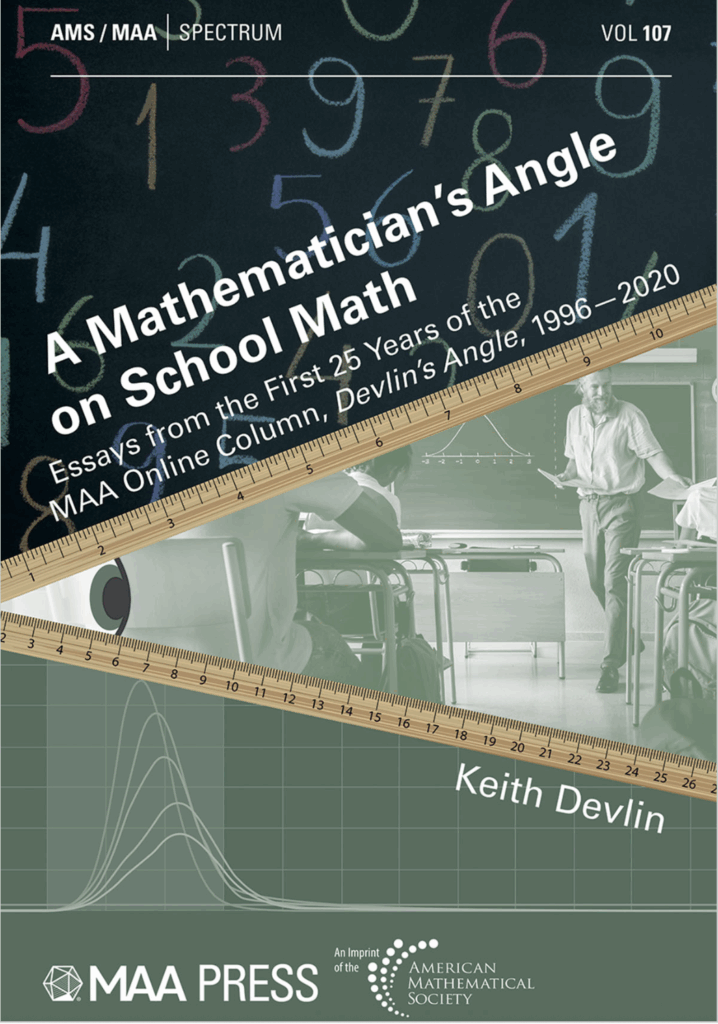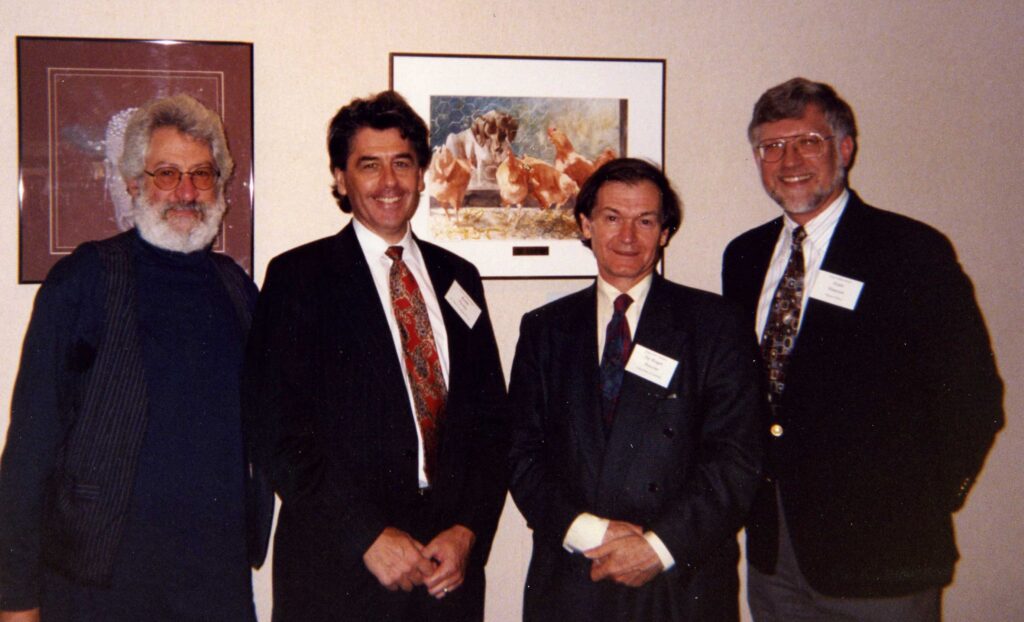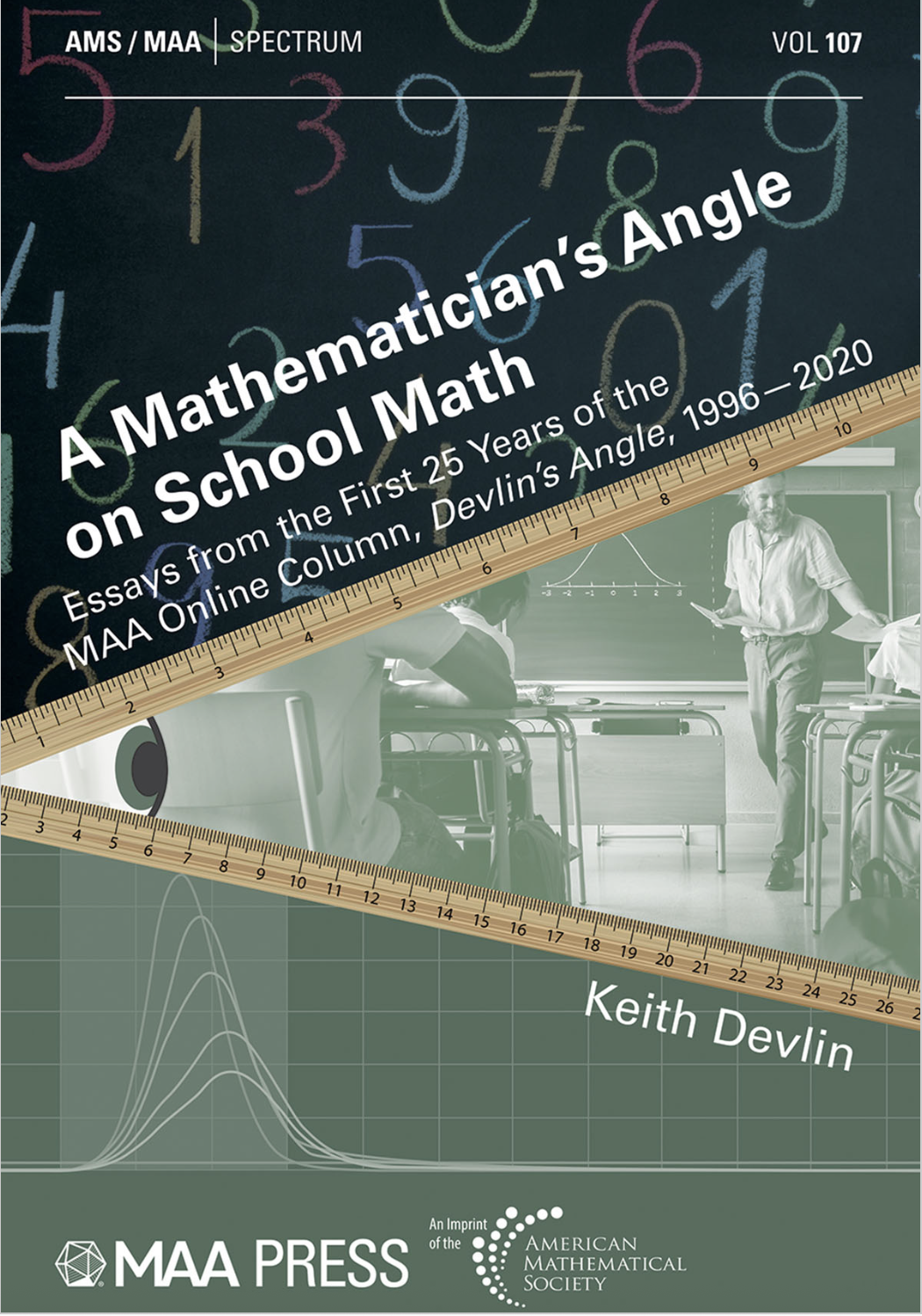By Keith Devlin @KeithDevlin@fediscience.org, @profkeithdevlin.bsky.social

Devlin’s Angle began in January 1996, as a feature in the MAA’s new online magazine (an “e-zine”). Today, just shy of thirty years later, it’s still going. There’s a complete archive of all the posts at https://profkeithdevlin.org/devlins-angle/. And now, there’s a Devlin’s Angle book, published by the MAA in its Spectrum series.
Written to celebrate the Angle’s first quarter century, it collects together 46 (out of 288 published in those 25 years) of the most popular essays that focus on, or have relevance to, K-12 mathematics learning. (The focus is on the learning, not the teaching, for which NCTM provides a range of publications.)
Sure, everything is available online. Well, not quite; the book collects together essays to form chapters on specific topics, each with a brief commentary, which brings out themes that are rarely perceived in the course of monthly web browsing, so can’t be easily discerned from the web archive. Moreover, the manuscript I sent to the MAA went through the usual review and editing process for any professionally published book, and the result is that the book you will see benefited enormously from several cycles of comments and edits from the Spectrum Board and the AMS publishing staff. (The fact that the individual posts had to be reproduced essentially just as they first appeared, apart from the correction of typos—it's a historical compilation—presented its own challenges.)
The result is (I hope) a convenient package that could make a nice Christmas present for math teacher friends or family members. After all, some teachers read MAA publications, but most do not. The book is very much intended as mathematical outreach.
You can find out what’s in the book by obtaining a copy. So far, it’s available only from the AMS Bookstore.
In this essay, which is about mathematical outreach in general, and some of the people who engage in it, I am going to point you to two Angle posts that you won’t find in the book. They are not there, because they focused on writing about mathematics for a general audience (not just the K-12 world). That’s a topic I’ve covered here and elsewhere a number of times over the years, most recently in a guest article in MATH VALUES (not in the Angle), published on March 29, 2022.
The two posts were published in July and August 2009, titled, respectively Trisecting Devlin’s Angle and In Praise of Good Editors. If you are curious as to why those last two links don’t lead you to an MAA website, read the Devlin’s Angle home page on my personal mathematical outreach website.
The two 2009 posts were part of an MAA initiative, started the year before, to encourage and support MAA members being public advocates for mathematics and mathematics learning.
In 2007, the Association had hired mathematics writer Ivars Peterson as the MAA Director of Publications for Journals and Communications, a position he held until December 2014.
Starting out as a high school science and mathematics teacher, Peterson became well known to the mathematics community with his 1998 bestselling book The Mathematical Tourist. Before coming to the MAA, he was (among many other things) a columnist and online editor at Science News, from 1981 until the MAA came looking in 2007.

In 2008, Peterson initiated (and organized) what became a four-year series of annual, residential (5 day-) workshops on mathematics writing for a general audience, held at the MAA headquarters in Washington, D.C. The instructors were Peterson, Paul Zorn, Underwood Dudley, and myself. The focus was on mathematical writing and editing for a wide variety of audiences and publications, from research journals to national and local newspapers. We led discussions on various aspects of the writing, editing, and publication process, from overall structure of an article or book down to the fine details of copy editing and punctuation. The two Angle posts linked to above describe some of the flavor of those workshops.
With Peterson at the helm, the MAA established itself as a leader in using the Web to get the math-message out. He was a strong advocate for the use of Twitter, which had launched in July 2006. As a result, I became an early user, and was active until it morphed into an Alt-Right domain (the Twitter/X-term would be “cesspit”) a few years ago. November 2022 was my last Angle post that carried my Twitter-handle (along with my newly acquired Mastadon handle, which was joined by a Bluesky handle in December 2023). Neither of those sites comes close to Twitter in its heyday in providing the math community with an easy way to reach large numbers of nonmathematicians, but it was good while it lasted.
Peterson received the Joint Policy Board for Mathematics Communications Award in 1991 for "exceptional skill in communicating mathematics to the general public over the last decade".
The photograph above shows (L to R) Ralph Abraham of UC Santa Cruz (1936-September 2024), yours truly, Sir Roger Penrose (b. 1931), and Peterson. The occasion was the Oregon Math Summit, organized by Terry Bristol, President and CEO of Oregon’s Institute for Science, Engineering, and Public Policy, at the request of the Oregon Superintendent of Public Instruction. The Summit brought together four-hundred K-16 mathematics teachers and mathematics education professors.
I wrote about the event in my October 1997 Angle. It was a blast.
In writing this post, I came across a blog about the event by Kirby Urner, who participated. (The term “blog” itself came a little bit later, by way of “weblog”. Urner was one of the earliest bloggers.) I don’t recall seeing his post before, but it’s a long time ago, and it’s likely I did. The link to his name shows some of the math outreach work he has done.
Given the momentum the arrival of the Web gave to mathematical outreach activities, it’s not so surprising that some of the online material created over the last thirty years is only now appearing in book form, the staple mass communication medium for two millennia. Devlin’s Angle has now joined that movement to close the circle. Which means that, at long last, circles can have angles.
I hope you enjoy the book.
DEDICATION. I am dedicating this post to the memory of Ralph Abraham. It was only when I was working on this essay that I discovered he had passed away, aged 88, last September. He was one of many talented individuals I have had the good fortune to interact with in my career. We all shared the joy that comes from not only doing mathematics, and occasionally (oh, how rare it is) discovering new mathematical facts, but sharing with others the wonderment and (mental) rewards it brings us.
